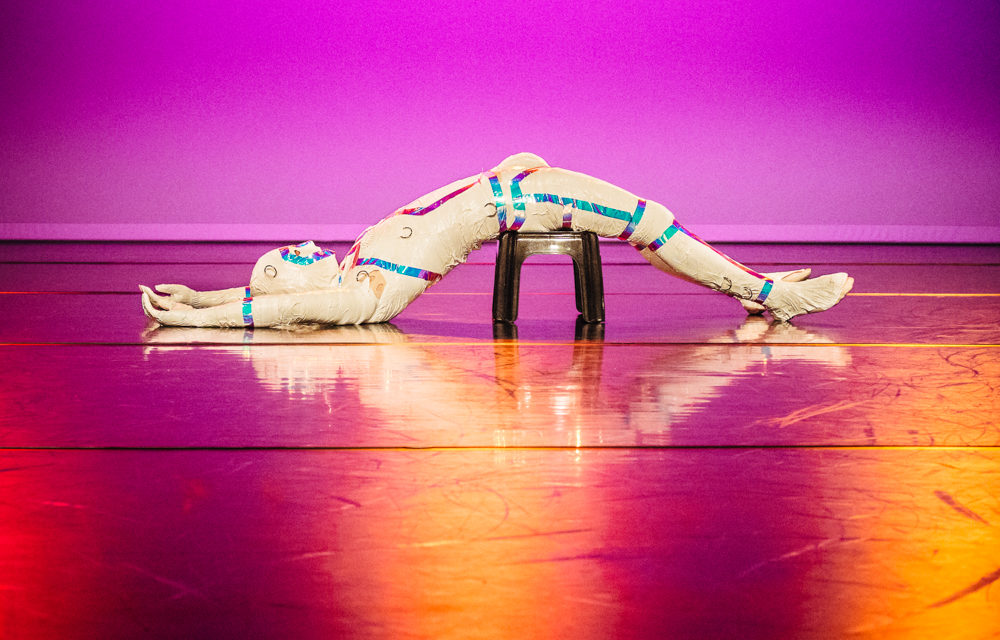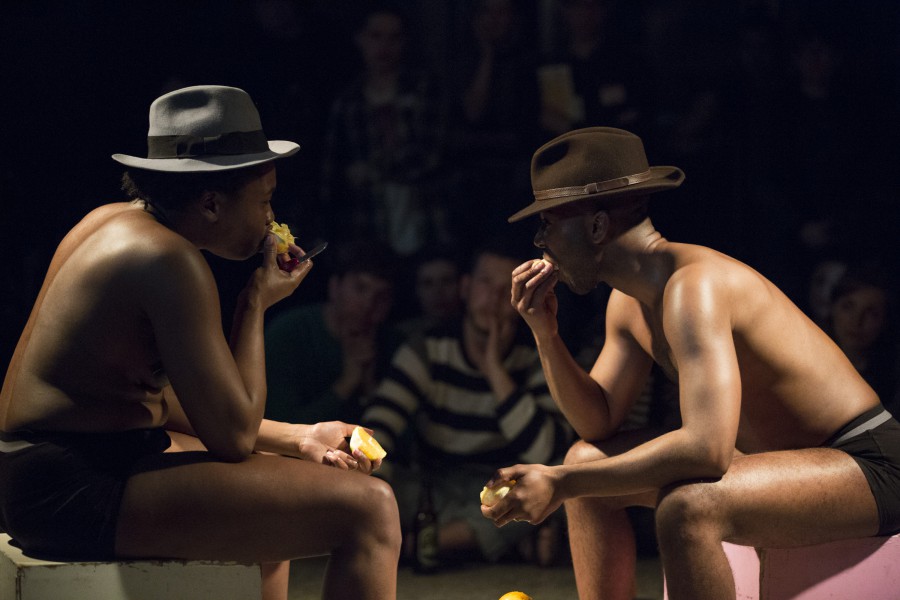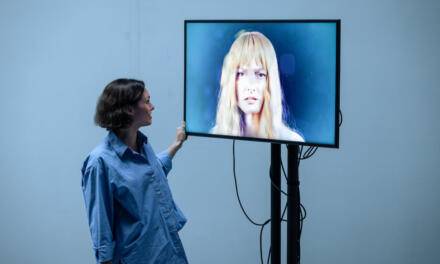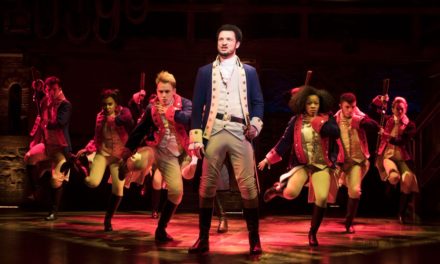Performance festival Steakhouse Live returns for 2016 with a beefier line-up and a new embedded writing programme led by Diana and Bojana. Here, they discuss the fest’s growth, and why we need to think about new models of criticism that can support the shape-shifting practices of live art.
Part One: Longer, Wetter, Faster, Better
Steakhouse Live came to be in Autumn 2013, when the first edition of what is now the annual festival took over Rich Mix for a day. Artist-led, low-budget and ambitious, it delivered a crammed programme filled with names that were not necessarily getting that much attention or traction in the capital. Risk, a buzzword that gets mentioned more than employed, was palpable: with no funding, no big headliners and no overwhelming institutional support, the collective behind Steakhouse put their taste, conviction and probably some of their own money on the line and on display in a way that was hardly hidden from view.
Three years later, the Rich Mix festival is a regular event, as is Tender Loin, a night of short performances at Toynbee Studios; having worked with over 120 artists, on 25 different events, in London and beyond, Steakhouse is no longer in its infancy. Similarly, the people behind the initiative arguably lost the right to the ‘emerging’ label some time ago. Katy Baird is about to embark on a national tour or her piece Workshy, Mary Osborn became an Artist Advisor at Artsadmin and Aaron Wright recently took on the position of the Artistic Director of Fierce.
Steakhouse, then, more than survived the process of emerging, and like many of the artists it champions came out the other end to face the inevitable ‘what now?’ question. The answer comes in the form of the 4th Steakhouse Live Festival, the first one to receive Arts Council support, with the intentions implied in its title – Longer, Wetter, Faster, Better. The event marks a whole lot of firsts for Steakhouse: it will take place over the course of three days (14-16 October), rather than one, and venture to three different venues, Rich Mix, The Yard Theatre and Toynbee Studios. The change of pace is also conceptual, rather than just formal: the programme this year includes two commissioned pieces (by Owen G Parry and Emma Selwyn), a night of club performances, a whole day dedicated to durational performance and an embedded critical writing project (led by the two authors of this text). Steakhouse also collaborated with Access All Areas to commission a graduate from their Performance Making Diploma for Learning Disabled Artists at the Royal Central School of Speech and Drama; Selwyn’s performance will be the result of that collaboration.
The programme itself remains largely faithful to the original idea behind Steakhouse, to create space for artists who don’t necessarily get too many invitations to the capital. Many of them, like Wladyslaw Kazmierczak & Ewa Rybska, Sandra Johnston, Katherine Araniello and Zerelda Sinclair, are well established; some, like Nicholas Tee and Selina Bonelli are still in the ‘emerging’ category, but have worked with Steakhouse before. The festival is curated through invitation, rather than open calls, and remains free of any thematic labels. Still, the intent to provoke discussions about the conflict between privilege and marginalisation, through the dissection of race, class, gender and body-concepts, is loud and clear. Rachael Young & Dwayne Antony and marikiscrycrycry explore queerness and black identity in two different pieces, Out and Assimilation; Nicholas Tee revives his childhood wish to transform from Chinese and Singaporean to White and Western; two artists, Jade Montserrat and Harold Offeh, take on the fetishization of white hair and the rituals of ‘fixing’ black hair; Michael Mayhew & Michael Barnes-Wynters confront the derogation of coons and chavs. Other class interruptions come from Lucy Hutson, who found inspiration in a Made in Chelsea binge, and Hester Chillingworth, replicating the glory of middle England in a durational piece that sees her repeating aloud every word coming out of Radio 4, while going about her day. Victoria Sin subverts gender norms through female drag to think about femininity, there will be a chance to idolise St Lavinia, of Titus Andronicus fame; Katherine Araniello promises to ‘endorse inspiration porn’ and ‘exude pity, wheelchairs, and sympathy.’
If there is a theme to Steakhouse Live it’s one of exclusion from the political and social mainstream – through race, class, gender, sexuality, disability – or reluctantly belonging to that same realm, through the same means. It’s a tension Live Art has always probed, and one that provides a foundation for every issue of inequality. These days, the frustrations observed and channelled by Steakhouse artists, however, basic their common denominator may seem, happen to coincide with those of the country as a whole. Hostility, racism and hate crimes, aimed at Eastern Europeans and people of colour, are rising at a rate so alarming even the mainstream media has had to acknowledge it. Class-based explanations for how Brexit happened have been prolific; the UK’s second female Prime Minister champions a permanent divide between the rich and the poor at age 11, while putting forward exactly zero policies that may bridge the gender pay gap or allow women to remain in the workforce. Rampant discrimination and political normcore were not born out of the referendum, but they were exposed by it for everyone to see. Disenfranchised identities and lives have been pulled from the margins to the limelight, where there will be negotiated, in formal talks and chance encounters, for years to come. As Steakhouse juxtaposes popular with marginalised, privileged with oppressed it’s not just the individual pieces, but also their dialogue with the specific political context that surrounds them, that we hope to explore through the Live Writing project.
Part Two: Criticism, live art, and model-building
For the embedded critical writing pilot for Steakhouse Live: Longer Wetter Faster Better, we wanted to bring two areas that often fold into one another together: criticism and live art. We wanted to start by facing some of these questions, whilst also dealing with them practically. The project is aimed at writers relatively new to the field of live art, but not to criticism, and at audiences both within the festival and outside of it.
The festival is an important context for the presentation of live art. Increasingly, festivals are providing spaces in which live works can be experienced, debated and considered, functioning with different rules than other cultural infrastructures. Festivals provide temporary communities that gather to experience work more intensely, and with curatorial or authorial contextualization. Foregrounding the importance of social spaces, festivals can often provide a fruitful overlap between conversation and experience, viewing and thinking. And this durational experience seems to remain under-served by criticism, despite such concerted, and culturally significant efforts for a more fruitful relationship that does not focus on a profession, but an approach.
At the same time, Live art, generally, does not tour well; it isn’t suited to long-runs, and it’s not specific to particular kinds of cultural spaces – it occupies a wide range, from public arenas to institutions, galleries and theatres.
Increasingly, new models are emerging: writers in residence programmes, training opportunities, talks, and debates; festivals are increasingly temporary bodies that can provide financial support to and platforms for criticism. Importantly, these are not always aimed at working critics, but at anyone interested in thinking about the work presented – artists, producers, writers and audiences. This should not be of threat to critics; we need to allow expertise to develop, and acknowledge that it comes from different places, and keep the doors open for the directions it might take.
At the same time, some dominant forms of criticism tend to either stay away from live art, accused of an academically-oriented, inward-facing language. That being said, individual critics and writers are increasingly making concerted efforts to address the lack of visibility of some performance practices over others, and digital publications, zines and other forms of publishing are emerging in support of this.
So, on the one hand, criticism institutionally is a foreign presence in live art, but as a set of practices, increasingly present. Partly, this has to do with different assumptions of the meaning of criticism itself; when we talk about criticism in live art, we also talk about an artistic strategy – live art’s ambition is critique- formal, topical, personal. In addition, criticism has some established, and problematic dominant practices: the short-form review; the star-rating system; the lack of infrastructural support for writers increasingly keen to be formally daring, and to occupy different kinds of spaces. In some ways, the support from these comes within the community, because the associations of criticism remain damaging, problematic and exclusivist.
A deeper look reveals practices that these practices of individuals or groups, which might seem marginal, are in fact integral to criticism and live art: writing from within; performative writing; experimental forms of critique; poetics; DIY publishing and artist-led critique – reflections that are multiple. So often, what falls under the rubric of criticism is already legislated by a highly problematic, and uncontested history. It’s important to underline that mainstream media outlets shy away from live art, and that their structures do not support practices that have a different approach to and attitude around artistic language and practice.Virtuosity doesn’t have a comfortable home within live art; and virtuosity is one of the tenets of traditional criticism, with its pleasures of the literary, its ambition towards journalistic objectivity, and ideas on cultural value. And it’s equally important to acknowledge the work of so many writers, curators, artists and organisations attempting to curate, and to take an active part in critical conversations surrounding live art.
To speak of a history of criticism in live art is to speak of a diversity of practices marginal to different contexts, academic, journalistic or artistic: the work of publications like Live Art Magazine (1994-2003) or Performance, for example, or the development of performance writing at Dartington College of the Arts. Just trawl through the Study Room at the Live Art Development Agency and you can uncover a plethora of forms of criticism, embedded within short-lived, but culturally significant publications, across landscapes from the academic book to the zine or pamphlet. The histories of these different forms of discourse weave so powerfully with those of live art, with its crossing of territories and visible re-positioning.If we want to trace a different history of criticism through these avenues, we need to look more carefully at how seemingly marginal practices collide with criticism.
In 2014, we curated a digital publication for Exeunt Magazine responding live to the live-stream of Forced Entertainment’s 1000thLIVE. A group of invited writers, sat at different computers across the UK and beyond, were to respond critically and instantly to the performance as it unfolded, guided by a set of parameters and reference points inspired by the piece, and by the nature of the project. This experience foregrounded the possibilities offered to criticism, performance and their audiences in the digital remit- and pursued the possibility of formal structures that respond to live performance and its shape, and that support its debates through different critical operations. It underscored that need to model-build and find spaces of plurality, or multiple voices and positions occurring simultaneously, with editorial, intellectual and accessible rigour.
This is, in part, our starting point for the project. We want to trace a wider set of reference points for live art criticism, whilst also developing a model that can support the identity of the festival, thinking through practice about what such a context requires of criticism, and how writing might be able to contribute to that.
Important to the project is also thinking about the counter-voice so fundamental to live art which can become central to inflections of criticism. This can support a nomadic, politicised practice. In the spirit of Weiner’s characterisations, we wanted to consider how form, duration, and voice play a part in criticism and its many possible iterations, digital, material or discursive.
The creation of communicative arenas resides as much with performance practice, as it does with criticism. We are experiencing a time of unprecedented scrutiny against criticality itself. Just take, for example, the political arena – Michael Gove’s pre-EU referendum statement that ‘we’ve had enough of experts’ is one of the many examples of post-truth politics, the idea that political success and rhetoric are not reliant on truth or factual information. How we talk about something, and the perceptions around that, are affected by wider cultural and political shifts. It is part of criticism’s cultural remit to resist anti-intellectualism and simplification of issues; we are interested in criticism being an active participant in creating open spaces, in bringing performance to other spheres of life.
Counter-voice is what sustains fiery debate, but it’s also appropriated by other mechanisms social and political. It is a challenge to the claims that expertise is an authority that mainstream criticism has, in the past and still now, taken for granted; but it is also an evidence that criticality is threatening, and it can also be unpopular. So how do we measure the meeting point between accessibility, care, and disagreement, between expertise without empty professionalisation? The challenge is to create spaces that are in equal measure open and uncomfortable, that decolonise and bring different voices in the mix not as tokenism, but as intent.
Criticism does not need to be threatened by obliteration – not by the dangers of journalism’s position in society, or the rise of the internet and its apparent democratisation of voice (the wrong impression that the internet is a space of free access devoid of corporatism or legislation). In the same manner in which we demand multiplicity from our art practices, formal, aesthetic and topical, so should we demand that of our criticism – and consider what models we build to support that.
Steakhouse Live is on from 14-16 October 2016. For the full programme, visit the Steakhouse website. Or follow the progress of the Steakhouse Live Writing project here.
This article was originally published on ExeuntMagazine.com. Reposted with permission. Read the original article.
This post was written by the author in their personal capacity.The opinions expressed in this article are the author’s own and do not reflect the view of The Theatre Times, their staff or collaborators.
This post was written by Diana Damian Martin.
The views expressed here belong to the author and do not necessarily reflect our views and opinions.



















